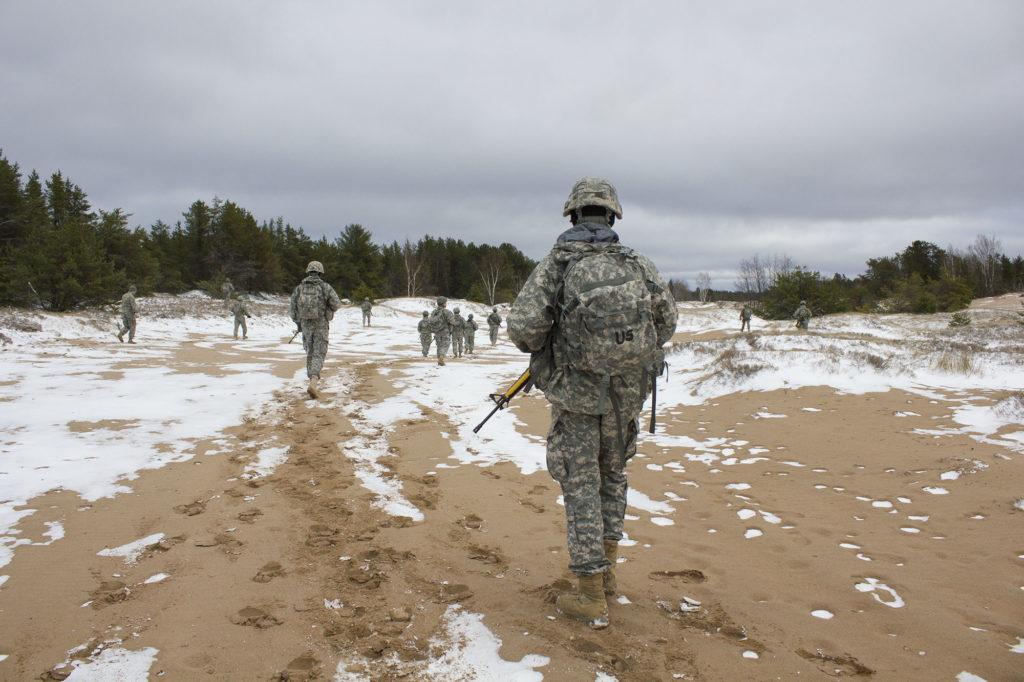Snow covered the ground and a brisk wind blew as ROTC students trudged through 108 acres of land for their lab exercise.
The Reserve Officer Training Corps (ROTC) program holds labs like this almost every Thursday. They also have navigation labs, which take place early in the fall semester while the weather’s still nice, said Lt. Col. Jonathan Rastall, head of the military science department.
Some labs are classroom-based, where the students learn about survival skills, such as how to layer their clothes, and also topics like preventing sexual assault.
The students grab their rubber guns that have the weight of an actual weapon and get into their formation for their movement to contact lab. This particular lab was led by senior political science major Sean McMillan. The point of the lab: to learn tactics and how to engage the enemy, Rastall said.
“The whole point of this and why we’re doing tactics, is not so we’re trying to create tactical genius, and that our cadets are going to know how to do this particular maneuver, it’s all about leader development,” Rastall said. “You put them in a situation, such as this, it’s kind of cold, they’re having to react to something that wasn’t initially planned for, maybe wasn’t part of their plan, then you see how they do. That’s where leader development occurs.”
The training starts out with a walkthrough of what the lab will entail and then a talk-through, said Rastall. The group starts moving, and the training begins. Within a few minutes, McMillan calls out “incoming,” and the group of about 25 students drop to the ground.
Shouts of “10 o’clock” and students running in that direction quickly follow as they get to their security positions and figure out what to do next. The students don’t know what the situation is, and must now determine what to do, McMillan said.
“The purpose of this lab is reaction to contact and reacting to indirect fires,” McMillan said.
Reacting to indirect fires is when the different groups are moving through terrain, like a wooded area, and receive indirect fire from the enemy. The second aspect is reacting to direct fire from enemy combatants themselves, McMillan explained.
“It’s used to test their ability to adapt to an ever-changing situation,” he said.
The students regroup and form their squad-platoon wedge formation, which makes it easier to put fire on the enemy and continue to move.
Not only do students react to direct and indirect fire, they must search the enemy they have taken down and get any information they can and render first aid if needed, Rastall said.
Students must also render first aid to their own who are down with “9-line”—nine steps they take to get information about the condition of the patient and parameters of the area to the medical personnel. Lines one through six: location; radio frequency, call sign and suffix; number of casualties; special equipment; number of patients and security at pickup site are the most important, McMillan said.
“Those lines of information are what allows them to get the helicopter in the air, so that the flight medic and flight surgeon know what equipment needs to be on that evac,” McMillan said.
Once the students have gone through a walkthrough of the lab, they stop and talk about what went well and what they did wrong and they do another round of the training.
One of the students who participated was junior mathematics major Carli Arends, who enlisted at 17 and plans to go into active duty after college and has found her ROTC experience invaluable.
“I think it’s very beneficial, especially with the tactical aspect,” Arends explained. “I went to basic training and we never went this in-depth. So to know every aspect of how each moving piece works is helpful, especially when you’re trying to develop yourself as a leader.”






























